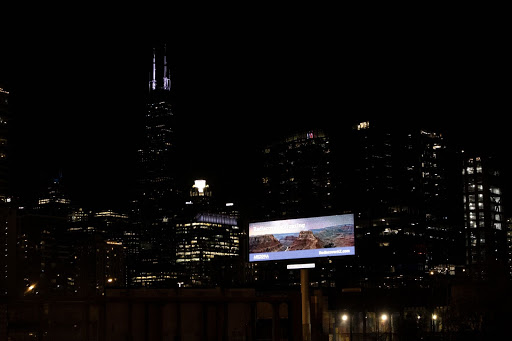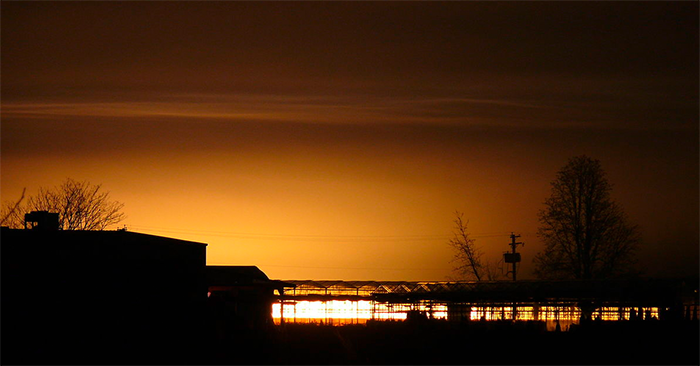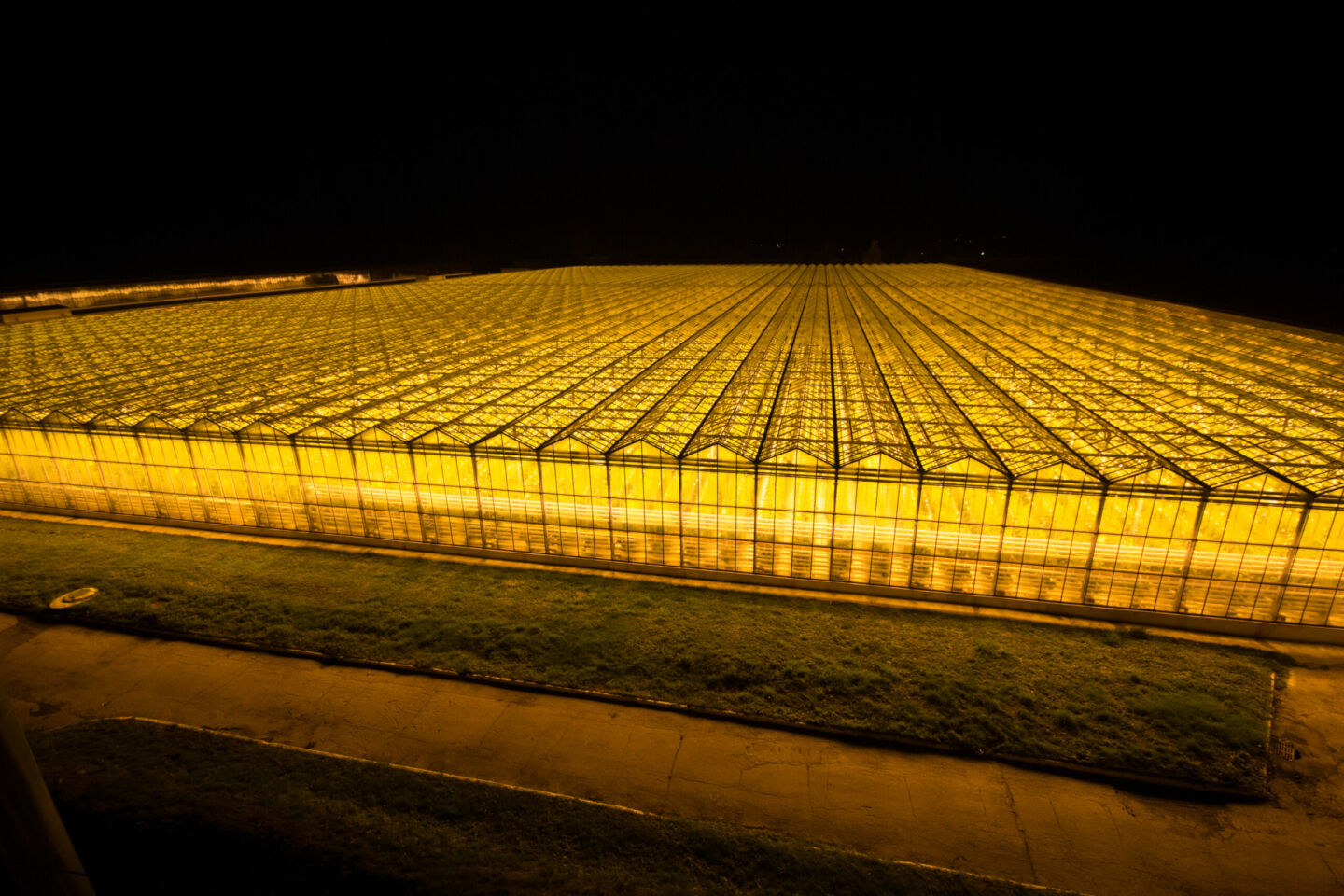
A land of perpetual false dawn
Commercial greenhouses contribute significantly to light pollution, often surpassing the output of entire towns. Regulations and technology can help mitigate the impact on dark skies.

Quite often when one thinks of light pollution the first image that comes to mind is of poorly shielded lights illuminating city streets. It’s time to expand our thinking.
A recent study conducted in Tucson, Arizona, showed that municipal street lights account for less than 20% of the light shining into the night sky. In cities, that means that lighting from other sources (illuminated billboards, parking lots, commercial, private, etc.) contribute to the majority of light at night.

Beyond large cities, that balance may be different. There, the total levels of light radiating into the night sky are often lower per capita too. A single bright source of artificial light at night may have an outsized effect on a small town. Power plants, shipping depots, or gas flares can match the output of a small town. But there may be no greater single source of light pollution for communities that host them than industrial greenhouses. A single mega-greenhouse can dwarf the light emissions of its host town by orders of magnitude.
By nature of the industry, commercial greenhouses are often developed near small or mid-sized towns where the large tracts of land they require — sometimes in the hundreds of acres — are inexpensive yet still within access to the large amounts of power they require. But it’s exactly these municipalities and nearby rural areas that are most sensitive to impacts on their nighttime environment. In a matter of months, once rural nights can be transformed by an intense, eerie glow rivaling an urban sky.
How much can these large-scale greenhouses affect the night? For some glaring examples look at these photo essays from the South Holland region of the Netherlands Glowing Dutch Greenhouses, As Seen From Way Up High and the Brittany region of France Les nocives aurores boréales de l’agriculture
For one particularly shocking example, we can look to the city of Yelets, Russia. Yelets is a city 400km south of Moscow with just over 100,000 residents. In late 2017 a new multi-acre greenhouse began operations just south of town. By the end of 2020, the light emanating from that one greenhouse complex outshone the entire city by nearly 100 times. On a per-capita basis compared to Yelets, that would mean this greenhouse emits the equivalent of a city of 10 million in their “backyard.” See if you can spot it.

Where are these mega-greenhouses? If you live in the global north they may not be far away. As the beginning of what hopefully will become a citizen science project, you can see the beginning of a more complete catalog in this Google Earth Project.

The rise of industrial greenhouses
These examples are indicative of a growing concern for those who care about the night skies. Commercial greenhouses may be a boon to the agricultural economy in intemperate climates and areas with limited sunlight. They allow complete climate and environmental control and offer an opportunity for regionally grown, high-quality produce without many of the risks and negative impacts of traditional farming like excessive use of pesticides and the threat of unpredictable weather. And the industry is booming. The 2020 Global Commercial Greenhouse Industry Report projected “the global market for Commercial Greenhouse[s] estimated at US$26.4 Billion in the year 2020, is projected to reach… US$43.8 Billion by 2027, growing at a [compound annual growth rate] of 7.5%”
A 2019 New York Times article about the Kentucky-centered greenhouse startup AppHarvest reported, “In July, AppHarvest signed a $15 million contract with Philips, the Dutch electronics company, for the LED system that will provide optimal lighting conditions for maximum plant growth. At night, AppHarvest’s 366-acre field, surrounded by Rowan County’s dark, forested landscape, will glow like a bright glass city.”
Chilling words for those concerned about light pollution.
A case study
Just 45 km (30 miles) southeast of downtown Detroit along the shores of Lake Erie are the agricultural towns of Kingsville and Leamington Ontario. They are at the center of an area experiencing explosive growth in the commercial greenhouse industry. The population of this region within Essex County is 48,000. Nearby Detroit has nearly 700,000 residents. Yet, during winter peaks, the region’s greenhouses can emit over 3x the light into the night sky than all of Detroit. That’s more than 46x the nighttime light per capita than Detroit’s residents emit. Even far off Detroiters noticed as their urban skies were affected.

It’s more than the loss of the night sky and the impact on its residents. Point Pelee National Park technically lies within the town of Leamington and was designated as a Dark Sky Preserve (DSP) by the Windsor Centre of the Royal Astronomical Society of Canada (RASC) in 2006. Point Pelee, the southernmost point of mainland Canada, is also an important preserve for migrating songbirds, As their website points out, “Most of the songbirds moving through Point Pelee in spring are nocturnal migrants.”
By 2018 the outcry began to grow. Looking at the plot above you can understand why. In only three years the light emissions from new greenhouses increased nearly 9-fold. On October 26, 2020, the Kingsville Town Council approved and adopted By-Law 96-2020, which in part prohibits and regulates public nuisances related to lighting from the cultivation of plants. This includes a limit on the hours of operation of obtrusive lighting and requiring blackout curtains during the nighttime use of grow lights.
The Leamington town council received nearly 1,300 comments on their proposed light abatement law (see pages 23-64). Nearly all were in favor of limiting the nighttime light from local greenhouses. The pleas at times are heart-wrenching:
“It really affects my sle[e]p and my child’s sleep. Very rough nights.”
“We chose the county to start our family because we wanted to raise our children in a small quiet community. We did not want the lights, noise, and odours of the city. Now we feel as if we have made the wrong choice. What happened to being able to see the stars at night? Instead, the sky looks like something out of a sci-fi movie. Nights should be dark. It should not even be a question. We should not have to put blackout curtains on all of our windows to be able to sleep at night. This is not normal at all.”
“I can’t sleep peacefully at night. The lights keep me up. It lights up my place. I’m exhausted!!!!! Bring back times where when it got dark the street lights turning on was an indication of going home….bring back times where the stars were easy to see. Yes, greenhouses do a lot for us, producing food we eat… but all we ask is for our peaceful black night sky.”
“This is now a land of perpetual false dawn. It is surreal, disorientating, and distracting. We need to have some semblance of a natural daily light cycle again.”
“It would be nice to see the stars in the sky again.”
On December 8, 2020, the Leamington council passed a bylaw to reduce greenhouse light pollution. Just 11 days later, CTV Windsor reported, “[A] group representing more than 200 greenhouse growers in Ontario wants to loosen new bylaws in Leamington and Kingsville meant to bring back the night sky from the nightly greenhouse glow.”
We’ll await the outcome of Kingsville and Leamington legislation. As data comes in from satellite observations we’ll be able to confirm whether the work of government officials on behalf of their residents’ pleas comes true. And perhaps their night will return.

What the future holds
This technology can benefit society but it doesn’t need to be at the expense of the night. As often experienced in the dark sky movement, if done right it can benefit us all. The light emitted from greenhouses at night is wasted energy and costs the producers. If technology can create these opportunities then technology can create solutions to these issues. It could be a win-win. Retractable shades for nighttime growing can not only help contain offending light but can also maintain heat within the greenhouse throughout cold nights. If the light within these greenhouses is reflected back at night to the crops perhaps less energy would be needed.
Yet there are still challenges for both the growers and the citizens who live within eyeshot. The growth of their impact has been fast. We can hope, for residents around the world facing this nightly blight, the solution can occur just as quickly.
But mitigating the impacts, as always, depend on the voices of the concerned.
More info
Read more about light pollution from greenhouses here.



















